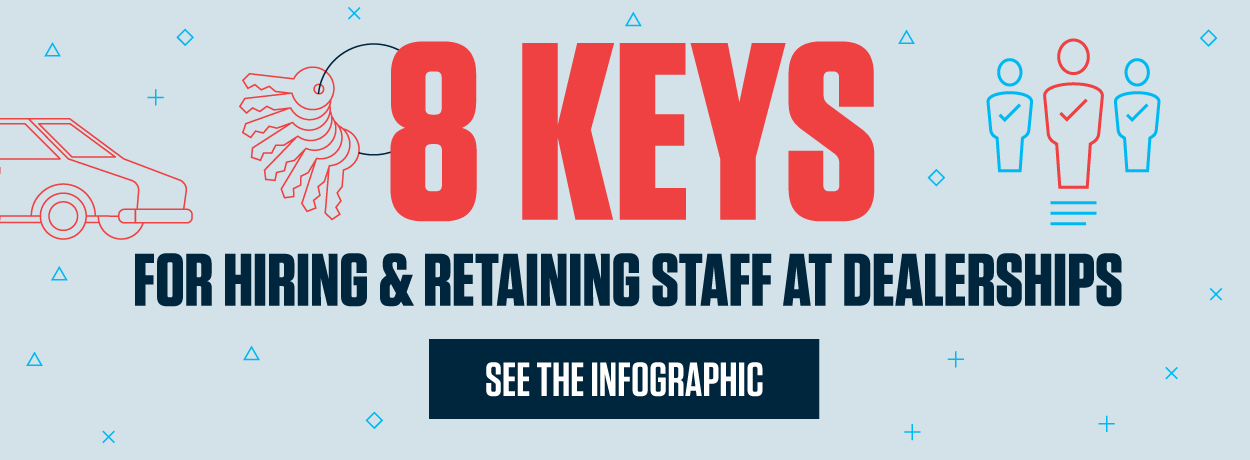Finding and retaining the right talent has never been more important or challenging for dealerships. They’re now facing the double whammy of historically low unemployment rates and high employee turnover. Fortunately, it turns out a modern DMS backed by a true technology partner might not only be important for streamlining your dealership operations, but also the trajectory of your hiring and retention strategy.
Many dealerships have traditionally followed a recruiting process where the goal is to find employees who already have experience with a specific DMS. That ties their hands in terms of who they interview. Instead of focusing on a prospective employee’s customer-facing skills, many dealerships find themselves fixed on an individual’s technology experience instead. That leaves a large number of talented applicants on the table all because of how hard it can be to learn a legacy system.
With overall staff turnover reaching 46 percent in 2017, according to NADA’s 2018 Dealership Workforce Study, dealerships can’t afford to be held back by the time it takes to train new talent on a legacy system. Making a switch to a modern DMS not only can help expedite the onboarding and learning process for new hires, but also sets them up to be more productive faster. This gives dealerships the flexibility they need to hire the right talent, rather than being limited to those who already know the DMS.
Leaving your legacy DMS behind to offer easy, open and flexible technology will also be key to catching — and keeping — the attention of younger generations who grew up with the latest technology constantly at their fingertips. However, the linchpin to winning over this younger talent lies in the training opportunities. According to a recent survey conducted by Qualtrics and Accel Partners, the number one thing Millennials want when starting a new job is sufficient training. Similarly, a Gallup report titled “How Millennials Want to Work and Live” revealed that 59 percent of Millennials cite opportunities to learn and grow as extremely important to them when applying for a job.
Employees want to continue refining their skills. They want a positive and exciting work environment, and that means mental growth and challenges. If nothing changes for them and they are constantly struggling with a technology system or spending excess time to get what they need, that impacts both employee growth and dealership productivity.
The technology landscape is changing more rapidly than at any other time in history, and if a dealership isn’t on board with that, they will get left behind. According to best-selling author Malcolm Gladwell, it takes 10,000 hours of practice to become an expert. Whether or not you take this theory literally, the overarching concept makes sense. Mastering or building on any skill requires ongoing training and practice. The same thing can be said for technology at the dealership. That’s why when it comes to making a technology switch, the training needs to begin right away and continue throughout an employee’s tenure, empowering them to further their professional development.
The continual training concept is being adopted throughout corporate America. Walmart Academies are teaching advanced retail skills and helping associates take charge of their careers. AT&T is adopting a continuous education culture and helping reskill current employees. Amazon is paying for employee education in specific fields. Each company has a different model, but they’re all trying to keep their employees on board and learning. It’s time for dealerships to take notice and do the same. This, however, will require finding a DMS provider who is your partner first and your vendor second.
Look for a provider who is willing to partner with you to deliver the training and education necessary to keep your employees engaged and using the DMS effectively. Make sure they offer training courses and online resources that your employees can access at their own speed. Enabling your employees to take control of their own development based on their needs, learning style and interests is vital to maintaining a positive and strong workforce.
Hiring, attracting and retaining staff is still the top challenge for dealership leaders today, and the Q1 2019 Cox Automotive Dealer Sentiment Index suggests it’s only getting harder. The top driver of buyer satisfaction in the dealership experience is their interactions with salespeople — even more than how long the car-buying process took or the price paid, according to the 2019 Cox Automotive Car Buyer Journey Study. If salespeople aren’t fulfilled, they aren’t representing your dealership well. Hiring and retaining the right people matters, and it’s up to you to work with your DMS provider to ensure you have the technology and training opportunities necessary to win talent over.
This article originally appeared on Digital Dealer here.
This is the final piece in a five-part series by John Grace on overcoming complacency and fear of change at the dealership.


